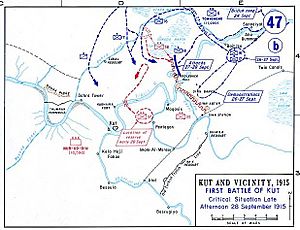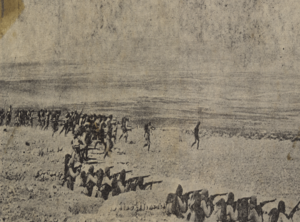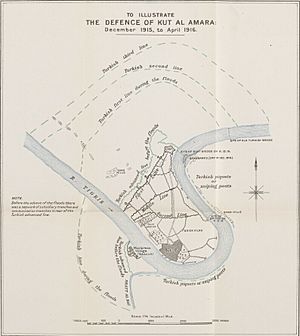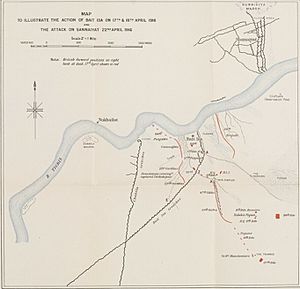Siege of Kut facts for kids
Quick facts for kids Siege of Kut |
|||||||
|---|---|---|---|---|---|---|---|
| Part of the Mesopotamian Campaign of World War I | |||||||
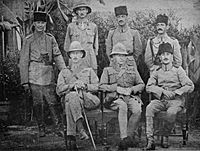 Charles Townshend and Halil Pasha after the fall of Kut |
|||||||
|
|||||||
| Belligerents | |||||||
| Commanders and leaders | |||||||
| Strength | |||||||
| 45,000 | 33,596 (December 1915) | ||||||
| Casualties and losses | |||||||
| 23,000 dead or wounded 13,164 captured including 6 generals |
unknown | ||||||
The Siege of Kut Al Amara was a major event during World War I. It happened between December 7, 1915, and April 29, 1916. During this time, the Ottoman Army surrounded a group of about 8,000 British soldiers. These soldiers were stuck in the town of Kut, which is about 160 kilometers (100 miles) south of Baghdad in what is now Iraq.
After many months, the British soldiers had to give up on April 29, 1916. The soldiers who survived were taken as prisoners of war. Many of them died during their journey to prison camps. Some historians have called this siege "the worst defeat" for the Allies in World War I. About ten months later, the British Indian Army managed to take Kut and Baghdad.
Contents
Why the Siege Happened
A British Indian Army group, led by Major-General Charles Townshend, had to pull back to Kut. They had just fought a battle at Ctesiphon and lost many soldiers. When they reached Kut around December 3, 1915, they had only about 11,000 soldiers left.
General Townshend decided to stay and defend Kut. He thought it was a good place to defend because it was inside a large bend of the Tigris River. However, getting supplies to Kut from Basra, a city far away, was very difficult.
The Siege Begins
The Ottoman forces, led by Halil Pasha, arrived on December 7, 1915. They quickly surrounded Kut. General Townshend realized his cavalry could escape, so he ordered them to leave.
The Ottoman army grew stronger as more soldiers arrived. They were led by a respected German general named Colmar Freiherr von der Goltz. He had helped modernize the Ottoman army before. After a few attacks, Goltz decided to build strong defenses around Kut. He also prepared for any British attempts to send help from Basra.
After a month, Townshend wanted to try to break out of Kut. But his commander, General Sir John Nixon, thought it was better to keep the Ottoman forces busy with the siege. Townshend reported that he only had one month of food left. This was not entirely true, as he had enough food for more than four months, though at reduced amounts. This confusing message caused delays in sending help.
Attempts to Help Kut
A rescue force of about 19,000 men was quickly put together. It was led by Lieutenant-General Sir Fenton Aylmer. They started moving up the river from Ali Gharbi in January 1916.
Battles to Reach Kut
The first attempt to help Kut happened on January 6. This was the Battle of Sheikh Sa'ad. British troops fought the Ottomans but could not defeat them easily. More British forces arrived the next day, and General Aylmer took command.
After heavy fighting, the Ottomans eventually pulled back from Sheikh Sa'ad on January 9. The British followed them, but heavy rains made it very hard to move.
The Ottomans then moved to a place called the Wadi. On January 13, Aylmer attacked them there. The Ottomans fought hard but then retreated again.
Next, the Ottomans set up camp at the Hanna defile. This was a narrow strip of land between the Tigris River and some marshes. The Battle of Hanna was a disaster for the British. They lost about 2,700 soldiers. This made the situation for the soldiers trapped in Kut even worse.
Life Inside Kut
As the siege continued, the soldiers inside Kut started to run out of supplies. Food became very scarce. Soldiers had to eat whatever they could find, even dried leaves or sawdust mixed with ginger. Many soldiers became sick with diseases like dysentery and scurvy because they didn't have enough food or clean water.
In March 1916, the Ottomans began to heavily bomb Kut with their artillery. This destroyed much of the town. German planes also dropped bombs, but they caused less damage.
General Townshend, worried about the situation, sent messages asking for a promotion. These requests made him look bad to others.
More Rescue Attempts Fail
Khalil Pasha, the main Ottoman commander, arrived with many more soldiers, increasing the Ottoman forces to 20,000 to 30,000 men.
After Aylmer's failed attempts, General Nixon was replaced by General Percy Lake. More soldiers were sent to help Aylmer's troops. Aylmer tried again on March 8, attacking a place called the Dujaila redoubt. This attack also failed, costing 4,000 British soldiers. General Aylmer was then replaced by General George Gorringe.
By April, the British soldiers in Kut were starving. Indian troops, who normally ate only vegetables, had to eat horse meat.
Gorringe's rescue attempts also failed. His forces were about the same size as the Ottomans, around 30,000 soldiers. They captured some areas but suffered heavy losses. Their final effort on April 22 against a place called Sannaiyat failed, with about 1,200 more soldiers becoming casualties.
During this time, the Royal Flying Corps tried to drop food and ammunition to the trapped soldiers from planes. This was one of the first times air supply was used in history. However, many of the packages fell into the river or into Ottoman trenches. The food they managed to drop was only enough for about three days.
All the rescue efforts failed. Around 30,000 Allied soldiers were killed or wounded trying to help Kut. The Ottomans lost about 10,000 soldiers. Baron von der Goltz, the German general, also died in April 1916, possibly from typhoid.
The Surrender
British leaders tried to buy their soldiers' freedom. They offered the Ottomans a large sum of money and promised not to fight them again. However, Enver Pasha, an Ottoman leader, refused the offer.
The British also asked Russia for help. A Russian general named Nikolai Baratov was in Persia with 20,000 soldiers. He started moving towards Baghdad, but turned back when he heard about the surrender.
General Townshend arranged a ceasefire on April 26. After talks failed, he surrendered on April 29, 1916. The siege had lasted 147 days. About 13,000 Allied soldiers became prisoners of war.
Life as Prisoners of War
The soldiers who were captured faced terrible conditions. On the day of surrender, the Ottomans gave them biscuits. One historian wrote that after eating them, many soldiers became very sick and died. They suffered from a stomach illness caused by contaminated biscuits.
Another historian compared the treatment of these prisoners to that of Allied prisoners held by the Japanese in World War II. It's unclear if the Ottomans planned to harm the prisoners or if it was due to neglect. One British prisoner described the march from Kut to prison camps as "appalling misery." Soldiers, already weak from the siege, were forced to march under a hot sun. Guards whipped them to make them move faster.
Some Indian prisoners were treated better if they were Muslim. Sikh and Gurkha prisoners, however, faced abuse because of their religions. When they reached Mosul, the landscape changed to mountains, and the local Kurdish people were sometimes kinder. But conditions in the prison camps were still very bad. One camp had Indian prisoners who looked like "animated skeletons."
General Townshend, the British commander, was taken to an island where he lived in comfort for the rest of the war. Some people criticized him for this, feeling he had abandoned his men.
The Siege of Kut is remembered in British Army history as the "Defence of Kut Al Amara."
What Happened Next
The loss of Kut was a huge defeat for Britain. General Lake and General Gorringe were removed from their commands. A new commander, General Stanley Maude, took over. He trained and organized his army.
Ten months after the siege, General Maude's army successfully captured the entire region from Kut to Baghdad on March 11, 1917. After Baghdad was taken, the British began to rebuild the war-torn country, and Kut was slowly restored.
Some Indian prisoners of war from Kut later joined the Ottoman forces. They fought alongside the Ottomans on different battlefronts.
See Also
- Second Battle of Kut, which happened in February 1917.


